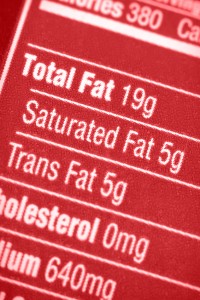 Any time you pick up a packaged food from your supermarket, you rely on its label to tell you what’s inside. When purchasing fresh foods like a stalk of celery or a bag of apples, you can inspect them for blemishes, mold and freshness, being reasonably certain of their overall quality.
Any time you pick up a packaged food from your supermarket, you rely on its label to tell you what’s inside. When purchasing fresh foods like a stalk of celery or a bag of apples, you can inspect them for blemishes, mold and freshness, being reasonably certain of their overall quality.
Processed foods, however, have none of these natural indicators of freshness or quality available, while at the same time contain far more ingredients.
Typically, you can’t even see the actual food you’re buying as it’s enclosed inside a bag or a box. The label is, therefore, the only resource you have to determine whether the food is a good choice for you and your family.
More than half of Americans surveyed as part of the U.S. Health and Diet Survey[i] indicated that they do, in fact, read food labels the first time they buy a product — but many said they are skeptical of claims like “low fat,” “high fiber,” or “cholesterol free” on the packages. And rightfully so.
Food labels are not always as forthcoming as they should be, and sometimes they are downright misleading. Here are some of the top lies to be aware of when reading a food label. After this, do not miss The Top 3 “Dirty Little Secrets” Lurking In The Pain Relief Industry’s Closet Of LIES! to learn how they are trying to con you, too!
6 Food Label Lies Every Health Seeker Should Know …
1. All Natural
Surprising as it may seem, the term “natural” on a food label means nada, zilch, zip! While meat, poultry and egg products that claim to be natural must be minimally processed with no artificial [ii]ingredients, any other food product can be heavily processed, pumped full of preservatives and even contain food coloring and artificial flavors, and still claim to be natural. The term simply has no legal or regulatory definition!
2. Zero Trans Fats
Most health-conscious consumers avoid artificial trans fats, which have been linked to cancer, diabetes, and heart disease, like the plague. These fats are so bad for your health that U.S. public health agencies have said there is no safe level of consumption. Food manufacturers know this, so they are quick to pepper their labels with claims of zero grams trans fat or “trans-fat free.”
But not so fast. The U.S. Food and Drug Administration (FDA) allows food manufacturers to round down when it comes to ingredients that account for less than 0.5 grams per serving. So your favorite trans-fat free chips or cookies? They could actually contain up to 0.5 grams of trans fat per serving, and still claim to have zero. The catch here is the per serving, as we all know most people do not stop at the recommended portion size. This means you could easily be taking in 1, 2 or more grams of trans fat for a food item you thought was trans-fat free. And considering there is no safe consumption amount, this could pose serious problems to your health. (As an aside, the “free from” definition of less than 0.5 grams applies to other ingredients too, such as gluten, sugar, alcohol, etc.).
3. Genetically Modified Ingredients
Think these are listed on the label? Think again. The FDA does not require special labeling for genetically modified (GM) foods, so its absence from a label does not mean a product is GM-free. Foods that are certified organic or state they are GM- or GMO-free, will be, however. Generally, virtually all non-organic processed foods, especially those that contain corn or soy, contain genetically modified ingredients.
4. Incidental Additives
Incidental additives are so-called “insignificant” ingredients that do not have to be listed on food labels. This includes, for example, substances that migrate into a food via its packaging. This is also why the recently highly publicized “pink slime” — beef scraps and connective tissue treated with ammonia that are added to ground beef — does not have to be listed on labels; the ammonia is technically a “processing agent,” not an ingredient, and the scraps and connective tissues are considered “meat.”
Other unsavory additives can also be in your processed foods sans labeling; think rodent droppings, insect parts and mold … These belong to a category known as “natural contaminants,” which the FDA considers a “natural” part of food production. Only when levels become exceedingly high does the FDA take action. For instance, the following are action levels for several common types of food (anything below this is legal and fair game):[iii]
- Chocolate: 60 or more insect fragments, or 1 or more rodent hairs per 100 grams
- Coffee: 10% or more are insect-infested or insect damaged, or moldy
- Frozen strawberries: Average mold count of 45% or more
5. Accuracy
You probably assume that if your ice cream carton says there’s 120 calories and 6 grams of fat in half a cup, that’s what you’re getting. But assumption may be the key word here. The last time the FDA conducted a systematic examination of food labels to test for accuracy was in 1996! So no one really knows whether nutrition facts are, in fact, fact. According to the Centers for Science in the Public Interest (CSPI):
“Some market observers speculate that one out of every four labels is inaccurate. Inaccuracies may include sugar in sugar-free products and fat and sodium content exceeding labeled claims.”
6. Cage-Free, Free-Range and Free-Roaming
Cage-free does not mean that the birds have access to the outdoors, only that they are uncaged (typically inside a warehouse or other building). While they must be able to roam freely, “cage-free” chickens are still often cramped inside factory farms, and beak cutting is allowed. Chickens used for meat are not ordinarily caged inside of factory farms, so the term “cage free” has little relevance or meaning. The term “free-range” is also misleading to consumers looking to support a healthier, more humane method of food production. While free-range poultry must be given some access to the outdoors, there are no requirements on how long or in how large of an area.
Next up … discover how the pain relief industry is trying to CON you, and the smarter solution instead, in…
 The Top 3 DIRTY LITTLE SECRETS Lurking In
The Top 3 DIRTY LITTLE SECRETS Lurking In
The Pain Relief Industry’s Closet Of LIES!
(click here to read now)


I am surprised so many people read ingredients, altho I suspect they don’t understand the lingo. There was joke going around, to annoy simpletons who claim “if you can’t pronounce it, it’s not good for you” — If food has dihydrogen monoxide in it, would you eat it? Of course they say no. Dihydorgen monoxide is scientific latin for normal drinking water !!!
Also, another survey found people are more likely to buy food labeled “natural”, than food labeled “organic”, altho “natural” is meaningless and “organic” is legally binding